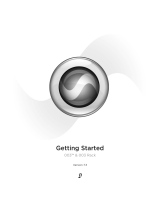
Legal Notices
This guide is copyrighted ©2007 by Digidesign, a division of Avid
Technology, Inc. (hereafter “Digidesign”), with all rights reserved. Under
copyright laws, this guide may not be duplicated in whole or in part
without the written consent of Digidesign.
003, 003 Rack, 96 I/O, 96i I/O, 192 Digital I/O, 192 I/O, 888|24 I/O,
882|20 I/O, 1622 I/O, 24-Bit ADAT Bridge I/O, AudioSuite, Avid, Avid
DNA, Avid Mojo, Avid Unity, Avid Unity ISIS, Avid Unity MediaNetwork, Avid
Xpress, AVoption, AVoption|V10, Beat Detective, Bruno, Command|8,
Control|24, D-Command, D-Control, D-Fi, D-fx, D-Show, DAE, Digi 002,
Digi 002 Rack, DigiBase, DigiDelivery, Digidesign, Digidesign Audio
Engine, Digidesign Intelligent Noise Reduction, Digidesign TDM Bus,
DigiDrive, DigiRack, DigiTest, DigiTranslator, DINR, DV Toolkit, EditPack,
Impact, Interplay, M-Audio, MachineControl, Maxim, Mbox,
MediaComposer, MIDI I/O, MIX, MultiShell, OMF, OMF Interchange, PRE,
ProControl, Pro Tools M-Powered, Pro Tools, Pro Tools|HD, Pro Tools LE,
QuickPunch, Reel Tape, Reso, Reverb One, ReVibe, RTAS, Smack!,
SoundReplacer, Sound Designer II, Strike, Structure, SYNC HD, SYNC
I/O, Synchronic, TL Space, Velvet, and X-Form are trademarks or
registered trademarks of Digidesign and/or Avid Technology, Inc. All other
trademarks are the property of their respective owners.
Product features, specifications, system requirements, and availability
are subject to change without notice.
PN 9320-56828 -00 REV A 7/07
Comments or suggestions regarding our documentation?
Communications and Safety Regulation Information
Compliance Statement
This model Digidesign Mbox 2 Mini complies with the following standards
regulating interference and EMC:
• FCC Part 15 Class B
• EN 55022
• EN 55204
• AS/NZS 3548 Class B
• CISPR 22 Class B
Radio and Television Interference




















